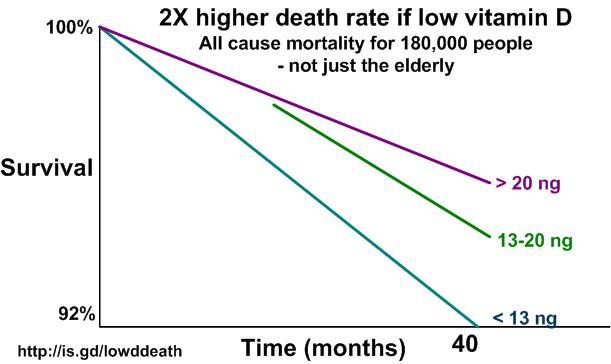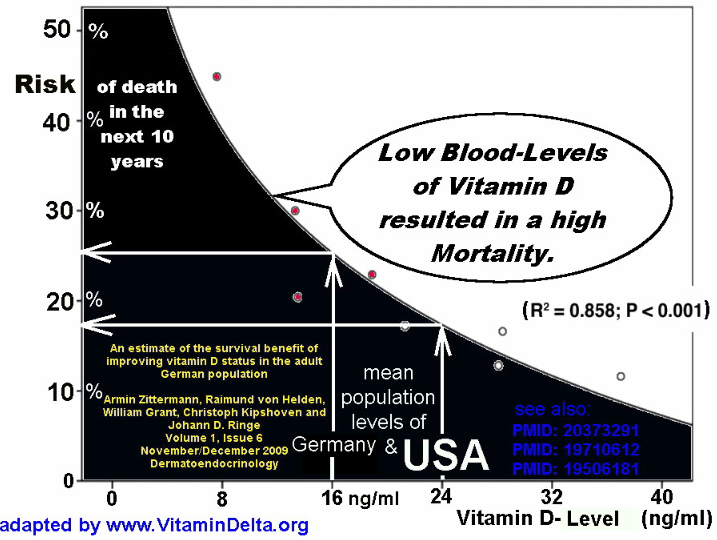People die sooner if they have low vitamin D
Serum 25-hydroxyvitamin D, mortality, and incident cardiovascular disease, respiratory disease, cancers, and fractures: a 13-y prospective population study
Am J Clin Nutr November 2014 ajcn.086413
Kay-Tee Khaw kk101@medschl.cam.ac.uk, Robert Luben, and Nicholas Wareham
From the Department of Public Health and Primary Care, Institute of Public Health, School of Clinical Medicine (K-TK and RL) and the Medical Research Council Epidemiology Unit (NW), University of Cambridge, Cambridge, United Kingdom.

📄 Download the PDF from VitaminDWiki.
Background: Vitamin D is associated with many health conditions, but optimal blood concentrations are still uncertain.
Objectives: We examined the prospective relation between serum 25-hydroxyvitamin D [25(OH)D] concentrations [which comprised 25(OH)D3 and 25(OH)D2] and subsequent mortality by the cause and incident diseases in a prospective population study.
Design: Serum vitamin D concentrations were measured in 14,641 men and women aged 42–82 y in 1997–2000 who were living in Norfolk, United Kingdom, and were followed up to 2012. Participants were categorized into 5 groups according to baseline serum concentrations of total 25(OH)D <30, 30 to <50, 50 to <70, 70 to <90, and ≥90 nmol/L.
Results: The mean serum total 25(OH)D was 56.6 nmol/L, which consisted predominantly of 25(OH)D3 (mean: 56.2 nmol/L; 99% of total). The age-, sex-, and month-adjusted HRs (95% CIs) for all-cause mortality (2776 deaths) for men and women by increasing vitamin D category were 1, 0.84 (0.74, 0.94), 0.72 (0.63, 0.81), 0.71 (0.62, 0.82), and 0.66 (0.55, 0.79) (P-trend < 0.0001). When analyzed as a continuous variable and with additional adjustment for body mass index, smoking, social class, education, physical activity, alcohol intake, plasma vitamin C, history of cardiovascular disease, diabetes, or cancer, HRs for a 20-nmol/L increase in 25(OH)D were 0.92 (0.88, 0.96) (P < 0.001) for total mortality, 0.96 (0.93, 0.99) (P = 0.014) (4469 events) for cardiovascular disease, 0.89 (0.85, 0.93) (P < 0.0001) (2132 events) for respiratory disease, 0.89 (0.81, 0.98) (P = 0.012) (563 events) for fractures, and 1.02 (0.99, 1.06) (P = 0.21) (3121 events) for incident total cancers.
Conclusions: Plasma 25(OH)D concentrations predict subsequent lower 13-y
total mortality and incident cardiovascular disease,
respiratory disease, and
fractures but not total incident cancers.
For mortality, lowest risks were in subjects with concentrations >90 nmol/L, and there was no evidence of increased mortality at high concentrations , suggesting that a moderate increase in population mean concentrations may have potential health benefit, but <1% of the population had concentrations >120 nmol/L.
From PDF: 99.5% = UK whites
See also VitaminDWiki
Less likely to die if have enough vitamin D - Meta-analysis June 2014 which has the following All cause mortality chart

40 ng Vitamin D perhaps optimal for reduced mortality – Meta-analysis Jan 2012 Dr. Grant
Death rate 2X higher at age 60 if low vitamin D - 180,000 in Israel May 2012 which has the following chart

See also web
Short url = http://is.gd/VitaminDMortality

